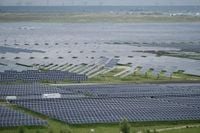High on the windswept Tibetan plateau, a sweeping transformation is underway—one that could reshape not only China’s energy landscape, but also the global fight against climate change. In July 2025, Chinese officials gathered in Hainan prefecture of western Qinghai province to unveil what they claim will be the world’s largest solar farm. Spanning an astonishing 610 square kilometers (235 square miles)—roughly the size of Chicago—this project is a testament to China’s ambition and breakneck pace in the renewable energy race.
The sheer scale of the endeavor is hard to fathom. As reported by the Associated Press, the landscape is now a sea of solar panels, broken only by the occasional white two-story building and, perhaps surprisingly, flocks of Tibetan sheep. These “photovoltaic sheep” graze contentedly on the scrubby plants that have taken root beneath the panels, thanks to the windbreaks and reduced soil evaporation the solar arrays provide. It’s a scene that energy administration chief Wang Anwei describes as a “win-win” for both production and ecology: electricity is generated above, while grass grows and sheep graze below.
China’s investment in solar power is not just about spectacle—it’s delivering real results. According to a study published in August 2025 and cited by both the Associated Press and UK-based Carbon Brief, China installed a staggering 212 gigawatts of solar capacity in the first six months of 2025 alone. For context, that’s more than the entire U.S. solar capacity of 178 gigawatts as of the end of 2024. Solar energy in China has already overtaken hydropower and, by the end of this year, is expected to surpass wind as the country’s largest source of clean energy. An additional 51 gigawatts of wind power was added from January to June, further boosting the country’s renewable portfolio.
The impact of these investments is beginning to show. The same study revealed that China’s carbon emissions edged down by 1% in the first half of 2025 compared to the same period in 2024, continuing a positive trend that began in March 2024. While a 1% drop might sound modest, it’s a significant milestone for the world’s largest emitter of greenhouse gases—especially since electricity demand in China actually grew by 3.7% over that period. For the first time, the growth in solar, wind, and nuclear power has not only kept pace with, but outstripped, rising electricity needs.
Lauri Myllyvirta, lead analyst at the Centre for Research on Energy and Clean Air and author of the study, underscored the importance of this shift. “We’re talking really for the first time about a structural declining trend in China’s emissions,” Myllyvirta told Carbon Brief. In his view, the fact that emissions are falling even as economic activity and power consumption increase marks a turning point. However, he cautioned that much more needs to be done if China is to meet its declared goal of carbon neutrality by 2060. “China needs to get to that 3% territory as soon as possible,” he said, referring to the average annual emissions reduction required over the next 35 years to hit the target.
For many climate watchers, this moment offers a rare glimmer of hope. Li Shuo, director of the China Climate Hub at the Asia Society Policy Institute in Washington, described the plateauing of China’s carbon emissions as “a moment of global significance, offering a rare glimmer of hope in an otherwise bleak climate landscape.” He added that the data demonstrates it’s possible for a country to cut emissions while still growing economically. But Li also issued a warning: China’s heavy reliance on coal remains a serious threat to further progress, and the economy must shift to less resource-intensive sectors if the momentum is to continue. “There’s still a long road ahead,” he said.
The solar farm on the Tibetan plateau is a microcosm of both China’s achievements and its challenges. With panels now installed on about two-thirds of the land, the completed project will boast over 7 million panels, capable of generating enough power for 5 million households. Yet, as Zhang Jinming, vice governor of Qinghai province, told journalists during a government-organized tour, there’s a fundamental problem: “The distribution of green energy resources is perfectly misaligned with the current industrial distribution of our country.” In other words, much of China’s renewable energy is being produced in the sparsely populated west, while the bulk of its population and industry are clustered in the east.
To bridge this gap, China is investing heavily in new transmission lines. One such line already connects Qinghai to Henan province, and two more are planned—including one stretching all the way to Guangdong province in the southeast, nearly the opposite corner of the country. These massive infrastructure projects are designed to move green electricity from where it’s generated to where it’s needed most. But technical and regulatory hurdles remain. As Myllyvirta explained, China’s electricity grid was originally designed for the steady, predictable output of coal-fired power plants, not the variable and sometimes unpredictable flows from solar and wind. “This is an issue that the policymakers have recognized and are trying to manage, but it does require big changes to the way coal-fired power plants operate and big changes to the way the transmission network operates,” he said. “So it’s no small task.”
The story of China’s solar surge is not without its critics. Environmentalists and energy experts alike warn that the country’s progress could be undermined if coal remains a dominant part of the energy mix. While the government’s targets are ambitious, and the recent emissions dip is encouraging, the road to carbon neutrality is fraught with economic, technical, and political obstacles. Balancing continued economic growth with the need for rapid decarbonization will test China’s resolve—and its ability to innovate at scale.
Still, the symbolism of the Tibetan solar farm is hard to ignore. Where once there was only desert and wind, now there is a glimmering expanse of solar panels, sheep grazing in their shade, and the promise—however tentative—of a cleaner, more sustainable future. As the world watches, China’s efforts to harness the sun on an unprecedented scale may well determine the global trajectory in the fight against climate change.






